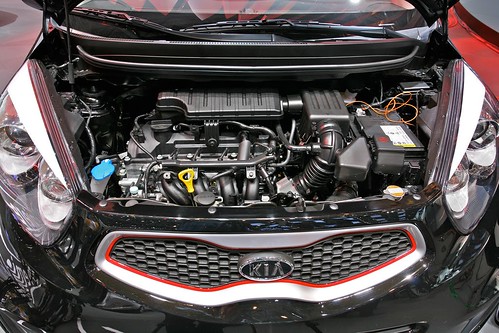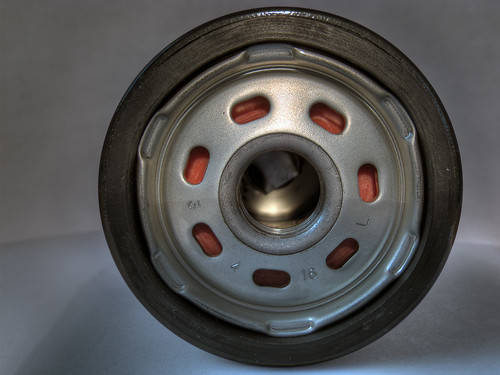Prevent engine trouble and save yourself some money by having your vehicle’s oil changed regularly. Some people prefer to take care of this task themselves rather than taking their vehicle in for maintenance. Here’s everything you need to know about how to change your own oil and why it’s important to do so in a timely way.
Tools and Materials Needed to Change Your Engine Oil

Image via Flickr by theKCB.
You’ll need several tools and materials to change your own oil. Some of these items you’ll only need to buy once, while others you’ll need to buy every time you plan to do an oil change. Tools required include a wrench to remove the drain plug (either a box-end or socket wrench will work), an oil filter wrench, an oil drain pan, a funnel, protective eyewear, and latex gloves.
It’s a good idea to keep some work towels on hand in case things get messy. Putting down plastic sheeting under your vehicle will help protect your driveway or garage floor. You’ll also need a jack and jack stands or ramps, depending on the ground clearance of your vehicle. Other required materials include oil, an oil filter, and a replacement drain plug gasket. How much oil and what type of oil you need can be found in your owner’s manual. Most auto supply stores have manuals listing the filter you’ll need as well.
How to Change Your Own Oil, Step by Step
Now that you’ve got the right supplies and tools, here’s how to do it.
Your vehicle’s engine and oil need to be warm when you begin. Let your vehicle cool down after it’s been running so it isn’t too hot. Take this time to raise your vehicle for better access if needed. Ask a friend for help to make sure your wheels are properly aligned with the ramps if you choose to use them instead of a jack and jack stands. If necessary, remove the aerodynamic undercover to access the engine’s oil filter and drain plug. Locate these items and place your drain pan below them, offset by several inches.
Loosen the oil fill cap on your engine before you begin. Next, drain the oil by quickly pulling the oil plug out and away from the stream of old oil. Let it completely drain until it stops dripping, moving the drain pan closer as needed. Clean the drain plug and install a new gasket if needed before putting the drain plug back in. Tighten the drain plug and wipe off any excess oil on the oil pan.
Move your drip pan under your oil filter to catch oil drainage. Unscrew the filter with your oil filter wrench and remove the filter. It’ll be full of oil, so place it quickly onto your drip pan in a position so it can drain. Take your new oil filter and wipe some clean oil on the face of the gasket. Install the new filter and tighten it with your wrench. Clean up any oil that may have dripped on your vehicle.
Next, place your funnel into the spout from which you previously removed the fill cap. Pour clean oil into your tank per the instructions your car owner’s manual’s instructions. Replace the fill cap and check the oil level according to your owner’s manual. Some vehicles require you to start the car before checking oil levels, while other vehicles can remain off. You also should check your oil pressure indicator on your vehicle’s dashboard to make sure it’s off.
Why Oil Changes Are Important

Image via Flickr by Razor512.
Oil changes are a necessary routine service maintenance to keep your vehicle performing at its best. Oil keeps the many parts of your engine working smoothly and efficiently. It helps pull heat away from the combustion chamber and reduces the accumulation of varnish and carbon in your engine. However, as the oil repeatedly passes through your engine, it degrades and becomes a sludge-like substance.
If you don’t change your oil regularly, your engine’s components won’t be properly lubricated and will wear down faster. Poor lubrication leads to greater friction and increased fuel consumption. It may also cause your engine to overheat. Oil and filter changes remove sludge and particles that make your engine dirty. If you don’t remove the dirt regularly, your engine will corrode and have a shorter lifespan.
Pros and Cons of Changing Your Own Oil
Changing your oil the first time can take a while depending on your knowledge of cars and your skill level. You also need to spend time and money gathering all the necessary tools and supplies. After the oil change, you must take the old oil somewhere to dispose of it properly. Changing your oil can also be a messy and dirty job.
The good news is that changing your own oil goes faster once you know how to do it. Sometimes it can take as little as 15 minutes. You may even enjoy the satisfaction of taking care of your own vehicle, and after the initial tool investment, you’ll save money by doing it yourself.
If you don’t have the time or skills needed to change your own oil, it’s easier for you to schedule an oil change at your local dealership. Simply show up and wait in a comfortable room while a technician with professional tools performs the task quickly. For greater peace of mind, leave your oil changes up to our quality service technicians, who know what’s best for your vehicle.
If you decide to change your oil, it’s a good idea to keep a maintenance record. Recording your vehicle’s mileage will help you know when it’s time to change your oil again. The general rule is every 3,000 to 5,000 miles, but it depends on the type of vehicle you drive. For some vehicles, you’ll need to reset the maintenance required light so it can alert you when it’s time to change your oil.
Performing Car Oil Changes by Yourself: the Bottom Line
At the end of the day, you should weigh the pros and cons: is it best to spend an hour or two of your Saturday to change your own oil, or should you trust the trained professionals? At our dealership, we frequently offer oil change specials. Consequently, you may find that the cost of doing it yourself isn’t much cheaper than employing an expert.
Do you have any questions about changing your own oil? If so, reach out to our service department today so we can help you.





 Warranties include 10-year/100,000-mile powertrain and 5-year/60,000-mile basic. All warranties and roadside assistance are limited. See retailer for warranty details.
Warranties include 10-year/100,000-mile powertrain and 5-year/60,000-mile basic. All warranties and roadside assistance are limited. See retailer for warranty details.